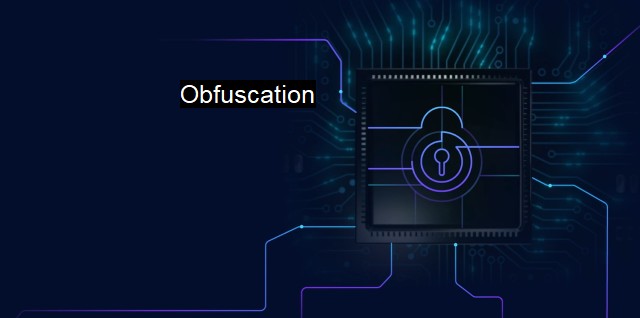What is Obfuscation?
The Role of Obfuscation in Cybersecurity: A Deceptive but Powerful Technique for Attackers and Defenders
Obfuscation is a commonly used technique of evading attribution and detection by obfuscating the source data in a way to prevent in-depth understanding. It is also a significant playing card in the hacker's arsenal used to mislead and create false narratives around an individual's data privacy.Typically, obfuscation refers to the practice of varying aspects of a software program to make its precise functionality difficult to ascertain. This means that the code is intentionally made less comprehensive and increasingly complex, becoming nearly impossible for someone else to understand or replicate. The intent can be innocent, such as protecting code from unauthorized use (a practice often used in licensed software), or with malicious intent - to mask viruses, Trojans, worms, and other cyber threats.
Even though terms often overlap obfuscation should not be confused with encryption. While both intend to protect data from unauthorized access, encryption transforms data into an unreadable form for those without the appropriate decryption key, whilst obfuscation makes the data challenging to understand but not necessarily unreadable.
Hackers driven with malicious exploits use obfuscation techniques to prevent, or at least delay, their intentions from being identified by system operators, antivirus algorithms, or cybersecurity professionals who are looking to protect or clean up after a security breach. They recognize the war between cybercriminals and cyber defenders is a war of knowledge. Someone who cannot comprehend the threat cannot be expected to defend themselves against it or mitigate its damage.
For instance, a common obfuscation tactic used by cyber-criminals in designing malware is through packing. When a virus is packed, the original code gets compressed and enveloped by a new shell of code. Because antivirus software’s malware detection algorithms categorize threats often based on known strings of malicious code, wrapping this virus conceals the genuine signatures.This allows the virus to bypass antivirus systems smoothly without being traced, right until the moment it is deployed.
Polymorphic malware exemplifies another dynamic approach for obfuscation, where a malicious code changes, or 'mutates', every time it gets installed on a different device. Each new variant encrypts differently, embellishing a new cipher not found on antivirus programs list of known malicious code sequences. More progressive variants of polymorphic malware reinscribe themselves entirely after each installation to avoid suspicion. These obfuscation techniques present a formidable challenge for security providers as they disrupt conventional malware detection processes.
The obfuscation landscape is not limited to offense only. Defense strategies in cybersecurity also deploy obfuscation in their DNA, referred to as 'security through obscurity.' This entails securing important data by obscuring critical specifics as part of the design's original security plan, making access almost impossible for unauthorized users.
It's an approach not without debate. Critics argue that for security-dependent systems, this kind of protection is inadequate just because once the obscurity gets thwarted, there typically are no other security measures putting up resistance. Despite these counterarguments, security through obscurity can be valuable as a multi-layered defense line. If an attacker must break through multiple layers of complexity, not to mention encryption to reach their target, then obfuscation becomes valuable.
Research communities persist to investigate code obfuscation theories and concepts, looking for mature procedures that lay out progressively unpredictable challenges for hackers. these pursuits onboard a broad range of mathematic, legal, and ethical complications. Time's assessment will be vital to determining obfuscation's future trajectory in cybersecurity.
Globally (and sadly) obfuscation won't be quite lost from the lexicon of the internet. With escalating ambition and capability of hackers, ensuring they're fickly understood is crucial in these digital wars of encryption, decryption, and security.
If utilized responsibly, obfuscation represents an additional fingerprint, an identifying logarithmic signature camouflaged in ambiguity capable of constructing hurdles for those attempting to infringe upon our digital existence with destructive purpose. As deliberate as obfuscation may be, the technical paucity of most cyberattack victims calls for enhanced clarity of this double-edged methodology in the cyber world.

Obfuscation FAQs
What is obfuscation?
Obfuscation is the practice of making software code or data difficult to understand, typically to hide its true purpose or to make it harder to reverse engineer.Why is obfuscation used in cybersecurity?
Obfuscation is used in cybersecurity to make it more difficult for malicious actors to analyze and exploit vulnerabilities in software code or data. It can also be used to protect sensitive information from being accessed or stolen.Are there any downsides to using obfuscation?
One potential downside to using obfuscation is that it can make it more difficult for legitimate users to understand and modify the software. It can also add complexity to the software development process and increase the risk of introducing new bugs or vulnerabilities.Do antivirus programs detect obfuscated code?
Many antivirus programs have built-in capabilities to detect and analyze obfuscated code. However, sophisticated obfuscation techniques can still make it difficult for antivirus programs to detect and respond to threats.Related Topics
Code obfuscation String obfuscation Polymorphic malware Metamorphic malware Stealth malware
| | A | | | B | | | C | | | D | | | E | | | F | | | G | | | H | | | I | | | J | | | K | | | L | | | M | |
| | N | | | O | | | P | | | Q | | | R | | | S | | | T | | | U | | | V | | | W | | | X | | | Y | | | Z | |
| | 1 | | | 2 | | | 3 | | | 4 | | | 7 | | | 8 | | |||||||